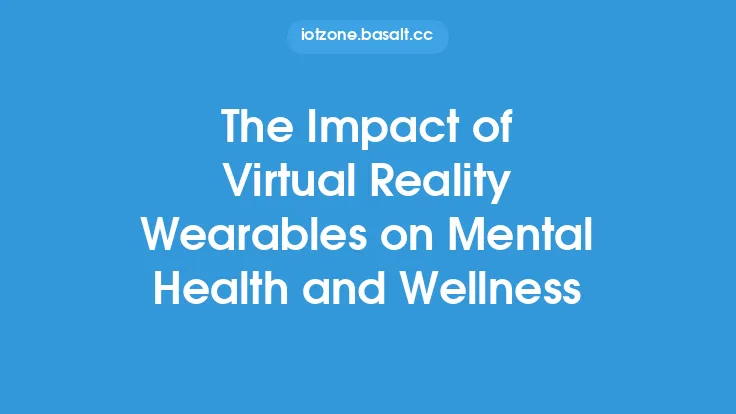The integration of virtual reality (VR) wearables into everyday life has been a topic of interest for several years, with many experts predicting a significant impact on various aspects of human life. From enhancing entertainment and education to revolutionizing therapy and treatment, VR wearables have shown tremendous potential. However, like any emerging technology, they also come with their own set of benefits and challenges.
Benefits of Virtual Reality Wearables
The benefits of VR wearables are numerous and varied. One of the most significant advantages is their ability to provide an immersive and interactive experience, which can be particularly useful in fields such as education and training. For instance, medical students can use VR wearables to practice surgeries in a simulated environment, reducing the risk of errors and improving their skills. Similarly, VR wearables can be used to enhance the entertainment experience, allowing users to engage with virtual objects and environments in a more immersive and interactive way.
Another benefit of VR wearables is their potential to improve mental health and wellness. Studies have shown that VR therapy can be an effective treatment for anxiety disorders, post-traumatic stress disorder (PTSD), and other mental health conditions. VR wearables can also be used to provide exposure therapy, which involves gradually exposing patients to simulated environments that trigger their anxiety or fear responses.
In addition to these benefits, VR wearables also have the potential to enhance productivity and collaboration in the workplace. For example, VR wearables can be used to create virtual meeting spaces, allowing remote teams to collaborate and interact in a more immersive and engaging way. They can also be used to provide training and education, reducing the need for physical travel and improving knowledge retention.
Challenges of Virtual Reality Wearables
Despite the many benefits of VR wearables, there are also several challenges that need to be addressed. One of the most significant challenges is the cost of VR wearables, which can be prohibitively expensive for many consumers. High-end VR headsets, such as the Oculus Rift or HTC Vive, can cost upwards of $1,000, making them inaccessible to many people.
Another challenge facing VR wearables is the issue of content availability. While there are many VR experiences available, the content is still limited compared to traditional forms of entertainment, such as movies or video games. This can make it difficult for users to find engaging and immersive experiences, which can limit the adoption of VR wearables.
Technical issues are also a significant challenge for VR wearables. Many VR headsets require powerful computers or gaming consoles to operate, which can be a barrier for users who do not have access to these devices. Additionally, VR wearables can be prone to technical issues such as lag, glitches, and tracking problems, which can disrupt the user experience and reduce immersion.
Technical Requirements of Virtual Reality Wearables
To understand the technical requirements of VR wearables, it is essential to delve into the underlying technology. VR wearables typically consist of a headset or device that displays a virtual environment, which is generated by a computer or gaming console. The headset uses a combination of sensors, such as accelerometers, gyroscopes, and magnetometers, to track the user's head movements and provide a seamless and immersive experience.
The technical requirements of VR wearables can be broadly categorized into two areas: hardware and software. On the hardware side, VR wearables require powerful processors, high-resolution displays, and advanced sensors to provide a smooth and immersive experience. The software requirements include operating systems, such as Windows or Android, and specialized software, such as VR engines and content creation tools.
One of the key technical challenges facing VR wearables is the issue of latency, which refers to the delay between the user's actions and the response of the virtual environment. To reduce latency, VR wearables use advanced technologies such as asynchronous time warp (ATW) and motion prediction, which can predict the user's movements and reduce the delay between the user's actions and the response of the virtual environment.
Future Developments and Trends
Despite the challenges facing VR wearables, the future of this technology looks promising. One of the most significant trends in VR wearables is the development of standalone headsets, which do not require a computer or gaming console to operate. These headsets, such as the Oculus Quest or HTC Vive Focus, use advanced processors and graphics cards to provide a seamless and immersive experience, without the need for external devices.
Another trend in VR wearables is the development of augmented reality (AR) technology, which overlays virtual objects and information onto the real world. AR wearables, such as smart glasses or AR headsets, have the potential to revolutionize industries such as education, healthcare, and entertainment, by providing users with interactive and immersive experiences that combine the virtual and real worlds.
In conclusion, VR wearables have the potential to revolutionize various aspects of human life, from entertainment and education to therapy and treatment. While there are several challenges that need to be addressed, the benefits of VR wearables make them an exciting and promising technology. As the technology continues to evolve and improve, we can expect to see more widespread adoption and innovative applications of VR wearables in everyday life.





